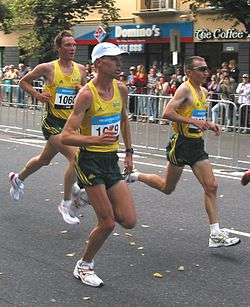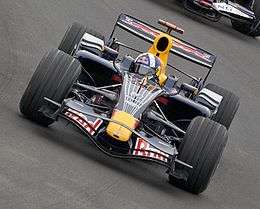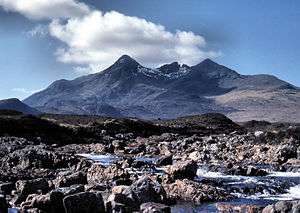Fell running
Fell running, sometimes known as hill running or mountain running, is the sport of running and racing, off road, over upland country where the gradient climbed is a significant component of the difficulty. The name arises from the origins of the English sport on the fells of northern Britain, especially those in the Lake District.
Fell races are organized on the premise that contenders possess mountain navigation skills and carry adequate survival equipment as prescribed by the organizer.
History

The first recorded hill race took place in Scotland.[1] King Malcolm Canmore organised a race in Braemar in 1040 or perhaps as late as 1064, reputedly to find a swift messenger. This event appears to have been a precursor to the Braemar Gathering. There is no documented connection between this event and the fell races of the 19th century.
From the 19th century records survive of fell races taking place as a part of community fairs and games. The sport was a simple affair and was based upon each community's values for physical ability. Fell races took place alongside other sports such as wrestling, sprint races and (especially in Scotland) heavy events such as throwing the hammer. These fairs or games events were often commercial as well as cultural, with livestock shows and sales taking place alongside music, dancing and sports. In a community of shepherds and agricultural labourers comparisons of speed and strength were interesting to spectators as a source of professional pride for competitors. A fast shepherd or a strong labourer were as respected, one imagines, as any top-ranking colleague in a more "modern" employment. The most famous of these events in England, the Grasmere Sports meeting in the Lake District, with its Guide's Race, still takes place every year in August.
The Fell Runners Association started in April 1970 to organise the duplication of event calendars for the amateur sport. As of 2013 it administers amateur fell running in England, in affiliation with UK athletics. Separate governing bodies exist for each country of the United Kingdom and each country has its own tradition of fell running, though the sport is largely the same. The most important races of the year include the Ben Nevis Race in Scotland, run regularly since 1937, and the Snowdon Race in Wales.
Overlap with other sports
Fell running is often known as hill running, particularly in Scotland.[2] It is sometimes called mountain running, as in the name of the Northern Ireland Mountain Running Association[3] although the term mountain running often has connotations of WMRA races which tend to be on smoother, drier trails and lack the route choice which may be available in fell races.[4]
Modern fell running has common characteristics with cross country running. Fell race courses are often longer, steeper and unmarked when out on the hills (with a few exceptions). Fell running also overlaps with orienteering. Courses are again typically longer but with less emphasis on navigation. Fell running does sometimes require navigational skills in a mountainous environment, particularly in determining and choosing between routes, and poor weather may increase the need for navigation. However, in most fell races, the route or sequence of checkpoints is published beforehand and runners may reconnoitre the course to reduce the risk of losing time working out where to run during the race.[5] Category O events and Mountain Marathons (see also below), test navigational ability, attracting both orienteers and fell runners. Other multi-terrain events, such as the Cotswold Way Relay and the Longmynd Hike, also qualify as fell races under Fell Runners Association rules.
Some fell running could also be classed as trail running. Trail running normally takes place on good paths or tracks which are relatively easy to follow and does not necessarily involve the significant amounts of ascent that are required in fell running.[6]
Rocks
Fell running does not involve rock climbing and routes are subject to change if ground nearby becomes unstable. A small number of fell runners who are also rock climbers, nevertheless do attempt records traversing ridges that allow running and involve scrambling and rock climbing – particularly where the record is 24 hours or less. Foremost of these in the UK is probably the traverse of the Cuillin Main Ridge on Skye, and the Greater Traverse, including Blaven.
Organizations
The Fell Runners Association publishes a calendar of 400 to 500 races per year. Additional races, less publicised, are organised in UK regions. The British Open Fell Runners Association (BOFRA) publishes a smaller calendar of races – mostly derived from the professional guide races – in England and Scotland and organises a championship series. In Scotland, all known hill races (both professional and amateur) are listed in the annual calendar of Scottish Hill Runners. In Wales, the Welsh Fell Runners Association provides a similar service. Northern Ireland events are organised by Northern Ireland Mountain Running Association. Again, races are run on the premise that a contender possesses mountain navigational skills and carries adequate survival equipment. In Ireland events are organised by the Irish Mountain Running Association.
The World Mountain Running Association is the governing body for mountain running and as such is sanctioned by and affiliated to the IAAF, the International Association of Athletics Federations. It organizes the World Mountain Running Championships. There are also the continental championships such as the African Mountain Running Championships and the European Mountain Running Championships, the South American Mountain Running Championships and the North American Central American and Caribbean Mountain Running Championships.
Championships
The first British Fell Running Championships, then known as Fell Runner of the Year, were held in 1972 and the scoring was based on results in all fell races. In 1976 this was changed to the runner's best ten category A races and further changes took place to the format in later years. Starting with the 1986 season, an English Fell Running Championships series has also taken place, based on results in various races of different lengths over the year.[7]
The winners of the British Championships have been as follows.[8]
| Year | Men | Women |
|---|---|---|
| 1972 | Dave Cannon | |
| 1973 | Harry Walker | |
| 1974 | Jeff Norman | |
| 1975 | Mike Short | |
| 1976 | Martin Weeks | |
| 1977 | Alan McGee | |
| 1978 | Mike Short | |
| 1979 | Andy Styan | Ros Coats |
| 1980 | Billy Bland | Pauline Haworth |
| 1981 | John Wild | Ros Coats |
| 1982 | John Wild | Sue Parkin |
| 1983 | Kenny Stuart | Angela Carson |
| 1984 | Kenny Stuart | Pauline Haworth |
| 1985 | Kenny Stuart | Pauline Haworth |
| 1986 | Jack Maitland | Angela Carson |
| 1987 | Colin Donnelly | Jacky Smith |
| 1988 | Colin Donnelly | Clare Crofts |
| 1989 | Colin Donnelly | Ruth Pickvance |
| 1990 | Gary Devine | Trish Calder |
| 1991 | Keith Anderson | Trish Calder |
| 1992 | Steve Hawkins | Clare Crofts |
| 1993 | Mark Croasdale | Angela Brand-Barker |
| 1994 | Mark Kinch | Angela Brand-Barker |
| 1995 | Mark Kinch | Sarah Rowell |
| 1996 | Ian Holmes | Sarah Rowell |
| 1997 | Ian Holmes and Mark Roberts | Angela Mudge |
| 1998 | Ian Holmes | Angela Mudge |
| 1999 | Gavin Bland | Angela Mudge |
| 2000 | Ian Holmes | Angela Mudge |
| 2001 | Cancelled due to foot-and-mouth outbreak | |
| 2002 | Simon Booth | Andrea Priestley and Louise Sharp |
| 2003 | Rob Jebb | Louise Sharp |
| 2004 | Simon Bailey | Tracey Brindley |
| 2005 | Simon Booth | Jill Mykura |
| 2006 | Rob Jebb | Natalie White |
| 2007 | Rob Hope | Janet McIver |
| 2008 | Rob Hope | Angela Mudge |
| 2009 | Rob Hope | Philippa Jackson |
| 2010 | Tim Davies | Philippa Maddams |
| 2011 | Morgan Donnelly | Philippa Maddams |
| 2012 | Joe Symonds | Lauren Jeska |
| 2013 | Rob Jebb | Victoria Wilkinson and Helen Fines |
| 2014 | Rob Hope | Victoria Wilkinson and Jacqueline Lee |
| 2015 | Finlay Wild | Jasmin Paris |
The winners of the English Championships have been as follows.[9]
| Year | Men | Women |
|---|---|---|
| 1986 | Dave Cartridge | Carol Haigh |
| 1987 | Bob Whitfield | Vanessa Brindle |
| 1988 | Shaun Livesey | Clare Crofts |
| 1989 | Gary Devine | Clare Crofts |
| 1990 | Shaun Livesey | Cheryl Cook |
| 1991 | Gavin Bland | Cheryl Cook |
| 1992 | Brian Thompson | Jacky Smith |
| 1993 | Mark Croasdale | Carol Greenwood |
| 1994 | Mark Kinch | Andrea Priestley |
| 1995 | Mark Kinch | Sarah Rowell |
| 1996 | Ian Holmes | Sarah Rowell |
| 1997 | Mark Roberts | Mari Todd |
| 1998 | Ian Holmes | Angela Brand-Barker |
| 1999 | Gavin Bland | Janet King |
| 2000 | Ian Holmes | Sally Newman |
| 2001 | Cancelled due to foot-and-mouth outbreak | |
| 2002 | Ian Holmes | Andrea Priestley |
| 2003 | Ian Holmes | Louise Sharp |
| 2004 | Simon Bailey | Louise Sharp |
| 2005 | Simon Bailey and Rob Hope | Sally Newman |
| 2006 | Rob Jebb | Natalie White |
| 2007 | Simon Bailey | Janet McIver |
| 2008 | Rob Jebb | Natalie White |
| 2009 | Simon Bailey | Philippa Jackson |
| 2010 | Rob Hope | Lauren Jeska |
| 2011 | Lloyd Taggart | Lauren Jeska |
| 2012 | Simon Bailey | Lauren Jeska |
| 2013 | Simon Bailey | Victoria Wilkinson and Helen Fines |
| 2014 | Tom Addison | Victoria Wilkinson |
| 2015 | Simon Bailey | Victoria Wilkinson |
Race categories
Race records vary from a few minutes to, generally, a few hours. The longest common fell running challenges tend to be rounds to be completed within 24 hours, such as the Bob Graham Round. Some of the mountain marathons do call for pairs of runners to carry equipment and food for camping overnight. Longer possible routes do exist, such as an attempt at a continuous round of Munros. Mountaineers who traverse light and fast over high Alpine, Himalayan or through other such continental, high altitudes are considered alpine style mountaineers by fell runners.
Races run under the FRA Rules For Competition of the Fell Runners Association[10] are categorised by the amount of ascent and distance.
Ascent categories
Category A
- Should average not less than 50 metres climb per kilometre.
- Should not have more than 20% of the race distance on road.
- Should be at least 1.5 kilometres in length.
Category B
- Should average not less than 25 metres climb per kilometre.
- Should not have more than 30% of the race distance on road.
Category C
- Should average not less than 20 metres climb per kilometre.
- Should not have more than 40% of the race distance on road.
- Should contain some genuine fell terrain.
Distance Categories
Category L
- A category “L” (long) race is 20 kilometres or over.
Category M
- A category “M” (medium) race is over 10 kilometres but less than 20 kilometres.
Category S
- A category “S” (short) race is 10 kilometres or less.
Additional categories used in the FRA Calendar published by the Fell Runners Association
Category O
- also known as a Long O event
- checkpoints are revealed to each competitor when they come up to a “staggered” start
- entry by choosing an orienteering type class, such as a Score-O event and often as a team of two (pairs)
Category MM
- events also known as Mountain Marathons and Mountain Trials
- similar to Category O, but multi-day events, in wild, mountainous country. Competitors must carry all the equipment and food required for the overnight camp and subsequent days. Entry is usually as a pair.
Three example "classic A" races
- Wasdale Fell Race AL 21 miles (34 km) 9,000 ft (2750 m) - male record 3:25:21 (Billy Bland, 1982), female record 4:12:17 (Janet McIver and Jackie Lee, 2008)
- Ben Nevis Race AM 10 miles (16 km) 4,400 ft (1340 m) - male record 1:25:34 (Kenny Stuart, 1984), female record 1:43:25 (Pauline Haworth 1984)
- Blisco Dash AS 5 miles (8.1 km) 2,000 ft (610 m) - male record 36:01 (Jack Maitland, 1987), female record 47:25 (Louise Sharp, 2004)
Footwear
Modern fell running trainers use light, non-waterproof material to eject water and dislodge peat after traversing boggy ground. While the trainer needs to be supple, to grip an uneven, slippery surface, a degree of side protection against rock and scree (loose stones) may be provided. Rubber studs have been the mode for two decades, preceded by ripple soles, spikes and the flat soled ‘pumps’ of the fifties.
24-hour challenges
Fell runners have set many of the peak bagging records in the UK. In 1932 the Lakeland runner Bob Graham set a record of 42 Lakeland peaks in 24 hours. His feat, now known as the Bob Graham Round, was not repeated for many years (in 1960); by 2011, however, it had become a fell-runner's test-piece, and had been repeated by more than 1610 people. Building on the basic 'Round' later runners such as Eric Beard (56 tops in 1963) and Joss Naylor (72 tops in 1975) have raised the 24-hour Lakeland record considerably. The present record is 77 peaks, and was set by Mark Hartell in 1997.[11] The ladies' record is 64 peaks, set in 2011 by Nicky Spinks.[12]
Most fell running regions have their own challenges or "rounds":
- Lake District – The Bob Graham Round
- Scotland – The Ramsay Round
- North Wales – The Paddy Buckley Round
- South Wales - South Wales Traverse
- Ireland – The Wicklow Round
See also
- Adventure racing
- Lakeland Shows
- Peak bagging
- Rogaining
- Trail running
- Ski mountaineering
- Skyrunning
- Ultrarunning
References
- ↑ Smith, Bill (1985). Stud Marks on the Summit: A History of Amateur Fell Racing: 1861-1983. Preston: SKG Publications. Retrieved 30 October 2011. - Total pages: 581
- ↑ "An introduction to hill running - runbritain". Retrieved 10 October 2016.
- ↑ Northern Ireland Mountain Running Association Constitution.,
- ↑ Sarah Rowell, Off-Road Running (Ramsbury, 2002), 104.
- ↑ "How it was for me - British Fell Running Championship 2015". Retrieved 10 October 2016.
- ↑ "Trail Running or Fell Running? - Fell Running Guide". Retrieved 10 October 2016.
- ↑ Steve Chilton, It's a Hill, Get Over It (Dingwall, 2013), 143-44.
- ↑ British Champions.
- ↑ English Champions.
- ↑ "FRA Rules For Competition" (PDF).
- ↑ Bunyan, John. "Mark Hartell's 24 Hour Lake District Record". Retrieved 10 October 2016.
- ↑ RaceKit news; Dark Peak Fell Runners news
Further reading
- Shevels, Keven. Introduction to Trail and Fell Running. ISBN 978-1-905444-40-3.
- Smith, Bill (1985). Stud Marks on the Summit: A History of Amateur Fell Racing: 1861-1983. Preston: SKG Publications. Retrieved 30 October 2011. - Total pages: 581
- Chilton, Steve (2013). It's a hill, get over it: fell running's history and characters. Dingwall: Sandstone Press. ISBN 978-1-908737-57-1.
External links
- Fell Runners Association
- Scottish Hill Racing
- British Open Fell Runners Association
- World Mountain Running Association


